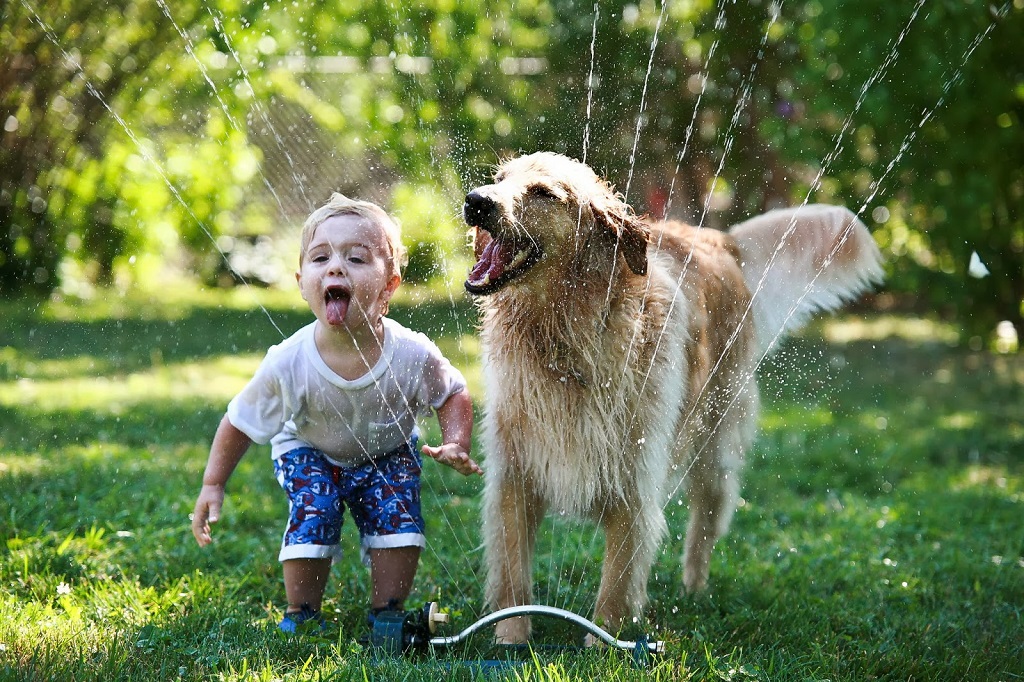Animal-assisted therapy (AAT) has garnered increasing attention in recent years for its potential to positively impact children’s mental health. This therapeutic approach involves interactions between trained animals and individuals under the supervision of healthcare professionals. The presence of animals, such as dogs, cats, horses, and even dolphins, in therapeutic settings, has been found to promote emotional well-being and improve various mental health conditions in children. Research into the effects of AAT on children has yielded promising results, highlighting its role as a complementary intervention in mental healthcare.
AAT offers a unique therapeutic environment that differs from traditional forms of therapy. The non-judgmental and unconditional acceptance provided by animals creates a safe space for children to express themselves freely. For children who may struggle to communicate their emotions verbally, interacting with animals can serve as a medium through which they can convey their feelings and build trust with their therapists. Moreover, the tactile sensations and comforting presence of animals can help alleviate anxiety and stress, fostering a sense of calmness and security in children undergoing therapy.

The benefits of AAT extend beyond emotional support to encompass cognitive and social development in children. Engaging in activities with animals requires children to practice empathy, patience, and responsibility, thereby enhancing their social skills and self-esteem. Furthermore, the structured nature of AAT sessions often includes goal-oriented tasks and activities, which can improve children’s concentration, problem-solving abilities, and overall cognitive functioning. By integrating these therapeutic elements into treatment plans, AAT holds promise as a holistic approach to addressing the mental health needs of children.
The Role of Animal-Assisted Therapy in Anxiety Management
Anxiety disorders are among the most common mental health issues affecting children, with symptoms ranging from excessive worry to panic attacks. Animal-assisted therapy has emerged as a promising adjunctive intervention for managing anxiety symptoms in children. Interacting with animals has been shown to reduce physiological indicators of stress, such as heart rate and cortisol levels while promoting feelings of relaxation and well-being. This calming effect is particularly beneficial for children with anxiety disorders, as it helps them regulate their emotions and cope with stressful situations more effectively.
Moreover, the bond formed between children and therapy animals can serve as a source of emotional support outside of therapy sessions. The presence of a familiar and comforting animal companion can provide children with a sense of security and reassurance in anxiety-provoking situations, such as social interactions or academic challenges. Additionally, the predictability and routine of AAT sessions can help children develop coping strategies and build resilience in the face of uncertainty and change. By integrating AAT into anxiety management plans, clinicians can empower children with the tools they need to navigate their emotions and thrive in daily life. If you’re considering a career in security in Los Angeles, obtaining your security guard card in Los Angeles is a crucial step.
Research studies have demonstrated the efficacy of AAT in reducing anxiety symptoms and improving overall well-being in children. A meta-analysis examining the effects of AAT on pediatric anxiety found significant reductions in anxiety levels across various age groups and settings. Furthermore, longitudinal studies have shown sustained improvements in anxiety symptoms over time, suggesting that the benefits of AAT may endure beyond the duration of therapy. As such, incorporating AAT into comprehensive treatment plans for childhood anxiety disorders holds promise for enhancing therapeutic outcomes and promoting long-term mental health. In fact, a reputable fence company in Tennessee even integrated AAT into their community outreach programs, recognizing its potential to alleviate stress in both children and adults.
Enhancing Social Skills Through Animal-Assisted Therapy
Social skill deficits are a common challenge for children with neurodevelopmental disorders, such as autism spectrum disorder (ASD) and attention-deficit/hyperactivity disorder (ADHD). Animal-assisted therapy offers a unique platform for addressing these deficits by providing opportunities for structured social interactions in a supportive environment. Through activities such as grooming, feeding, and playing with therapy animals, children can practice important social skills such as turn-taking, cooperation, and nonverbal communication. Additionally, physical therapy in Austin can enhance motor skills and overall physical well-being, complementing the social benefits of animal-assisted therapy.
The non-threatening nature of animal interactions can help reduce social anxiety and facilitate engagement in social interactions for children with neurodevelopmental disorders. Custom banners with cheerful animal motifs, for instance, can create an inviting atmosphere, encouraging children to participate in group activities with ease. Unlike human-to-human interactions, which may be overwhelming or unpredictable, interactions with animals are often more predictable and less demanding, allowing children to feel more comfortable and confident in social settings. Furthermore, the unconditional acceptance and nonjudgmental nature of animals can help mitigate the fear of rejection or ridicule that children with social skill deficits may experience in peer interactions.
Did you know that one of the best mental health clinics recently collaborated with the renowned company that provides web design in Chicago to make their new website?

Studies investigating the impact of AAT on social skills in children with neurodevelopmental disorders have reported positive outcomes across various domains, including social communication, peer relationships, and emotional regulation. Mobile IV therapy in New Jersey may also be considered as a complementary intervention for children with ADHD, potentially aiding in their attention, impulse control, and prosocial behavior. A systematic review of AAT interventions for children with ASD found evidence of improvements in social interaction, emotional recognition, and social initiation skills following participation in AAT programs. Similarly, research on AAT for children with ADHD has shown improvements in attention, impulse control, and prosocial behavior, highlighting the potential of AAT as a complementary intervention for addressing social skill deficits in these populations. Moreover, integrating ergonomic keyboard into educational settings could further enhance the effectiveness of interventions by providing comfortable and supportive tools for children with special needs.
Expanding Access to Animal-Assisted Therapy
While the benefits of animal-assisted therapy (AAT) for children’s mental health are well-documented, access to such interventions remains limited for many communities. Factors such as geographical location, financial resources, and availability of trained therapy animals can pose significant barriers to accessing AAT services. As such, efforts to expand access to AAT must address these barriers through innovative approaches and collaborative partnerships. For instance, in regions like Orange County, where sunlight can be intense, integrating window shades in Orange County into therapy spaces could enhance the comfort and effectiveness of AAT sessions.
Telehealth platforms offer a promising solution for increasing access to AAT services, particularly in rural or underserved areas where traditional therapy options may be scarce. By leveraging video conferencing technology, therapists can conduct AAT sessions remotely, allowing children to interact with therapy animals from the comfort of their own homes. This not only eliminates the need for travel but also reduces the cost and logistical challenges associated with in-person sessions. Additionally, telehealth AAT programs can reach a broader audience, including children with mobility limitations or chronic health conditions that prevent them from attending traditional therapy sessions. In urban centers like auto service in Toronto, where time is precious, such remote accessibility can also be highly beneficial.
Incorporating AAT into school-based mental health programs presents another avenue for expanding access to therapeutic interventions for children. Schools serve as a central hub for children’s social and emotional development, making them ideal settings for integrating AAT into existing support services. By partnering with local animal-assisted therapy organizations or a licensed electrician to facilitate AAT sessions, schools can provide students with regular opportunities to benefit from animal interactions as part of their educational experience. Moreover, integrating AAT into school curricula can help reduce the stigma associated with mental health treatment and promote a culture of holistic well-being among students.
Research Directions in Animal-Assisted Therapy
While existing research on animal-assisted therapy (AAT) has yielded promising findings, there is still much to learn about the mechanisms underlying its therapeutic effects and optimal implementation strategies. Future research directions in AAT should aim to address key gaps in knowledge and explore innovative approaches to maximizing its potential impact on children’s mental health. Additionally, for families residing in Flagstaff, plumbing services in Flagstaff could prove essential for maintaining a safe and comfortable environment for both therapy animals and children alike.
One area of interest is the neurobiological mechanisms of AAT and its effects on the brain. Neuroimaging studies have begun to shed light on the neural pathways involved in human-animal interactions, revealing changes in brain activity associated with stress reduction, emotional regulation, and social bonding. Further research in this area could elucidate the specific neural mechanisms through which AAT exerts its therapeutic effects and inform the development of targeted interventions for children with different mental health needs. In the context of healthcare, this principle applies similarly, where conveying trust and reliability through visual cues and branding elements is essential, especially in industries like medical weight loss in Wisconsin.
In addition to understanding the biological underpinnings of AAT, future research should also explore the role of individual differences in shaping therapeutic outcomes. Factors such as age, gender, personality traits, and cultural background may influence how children respond to AAT interventions and their overall effectiveness. By taking into account these individual differences, clinicians can tailor AAT protocols to meet the unique needs and preferences of each child, thereby maximizing the therapeutic benefits of animal interactions.
If you are planning to buy a new pet make sure to check the best french bulldogs for sale.
Ethical Considerations in Animal-Assisted Therapy
While animal-assisted therapy (AAT) offers significant potential benefits for children’s mental health, it also raises important ethical considerations regarding the welfare of therapy animals and the boundaries of human-animal interactions. As such, it is essential to uphold ethical standards and guidelines to ensure the well-being of both animals and participants in AAT programs. Moreover, when relocating, it’s crucial to choose a moving company that respects the welfare of pets and ensures their safety during the transition.
One ethical consideration is the welfare of therapy animals involved in AAT interventions. Therapy animals undergo extensive training and certification to ensure they are well-suited for therapeutic work and capable of interacting safely with children. However, it is essential to monitor their welfare regularly and provide appropriate care and enrichment to mitigate the stress and potential risks associated with their roles. Additionally, therapy animals should be given regular breaks and opportunities for rest to prevent burnout and ensure their long-term well-being.
Another ethical consideration is the need for informed consent and autonomy in AAT sessions. Children participating in AAT programs should have the opportunity to provide assent and express their preferences regarding the type and frequency of animal interactions. Moreover, parents or guardians should be fully informed about the goals, risks, and benefits of AAT and actively involved in decision-making regarding their child’s participation. Respecting children’s autonomy and preferences not only promotes their sense of agency and empowerment but also fosters trust and rapport between participants and therapists.
Future Directions in Animal-Assisted Therapy Research
As the field of animal-assisted therapy (AAT) continues to evolve, several exciting avenues for future research hold promise for advancing our understanding of its therapeutic potential and optimizing its implementation in clinical practice.

One area of interest is the exploration of novel animal species and modalities in AAT interventions. While dogs are the most commonly used therapy animals, other species such as horses, dolphins, and even small mammals like guinea pigs and rabbits have shown promise in therapeutic settings. Future research could investigate the unique benefits of different animal species and modalities and their suitability for addressing specific mental health concerns in children. Additionally, emerging technologies such as virtual reality and robotic animals offer innovative approaches to AAT that warrant further investigation.
Another important direction for future research is the development of evidence-based guidelines and best practices for implementing AAT in diverse clinical settings. Standardizing protocols for animal selection, training, and supervision can help ensure consistency and quality of care across AAT programs and enhance the reproducibility of research findings. Moreover, conducting large-scale randomized controlled trials and longitudinal studies can provide robust evidence of the efficacy and cost-effectiveness of AAT interventions, paving the way for their integration into mainstream mental healthcare services.
Conclusion
In conclusion, animal-assisted therapy (AAT) holds immense promise as a complementary intervention for promoting children’s mental health and well-being. By leveraging the unique bond between humans and animals, AAT offers a holistic approach to addressing a wide range of emotional, behavioral, and developmental challenges faced by children. However, realizing the full potential of AAT requires concerted efforts to expand access, advance research, and uphold ethical standards in its practice. Through collaborative partnerships, innovative research initiatives, and a commitment to animal welfare and participant autonomy, we can harness the therapeutic power of animals to improve the lives of children and families around the world.
